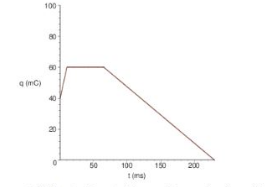The charge stored on a capacitor's plates increases from an initial value of 40 mC to a maximum of 60 mC, and then decreases to zero, varying with time according to the graph shown here. a(MC) (t)= 50 (t) = 60 i(t) = 100 60 40 20 50 symbolic formatting help 100 150 (ms) What is the current i(t) flowing through this capacitor as a function of time? 200 XA, for 0 < t < 10 ms X A, for 10 < t < 65 ms XA, for 65 < t < 230 ms.
The charge stored on a capacitor's plates increases from an initial value of 40 mC to a maximum of 60 mC, and then decreases to zero, varying with time according to the graph shown here. a(MC) (t)= 50 (t) = 60 i(t) = 100 60 40 20 50 symbolic formatting help 100 150 (ms) What is the current i(t) flowing through this capacitor as a function of time? 200 XA, for 0 < t < 10 ms X A, for 10 < t < 65 ms XA, for 65 < t < 230 ms.
Delmar's Standard Textbook Of Electricity
7th Edition
ISBN:9781337900348
Author:Stephen L. Herman
Publisher:Stephen L. Herman
Chapter20: Capacitance In Ac Circuits
Section: Chapter Questions
Problem 5PP: Three capacitors having capacitance values of 20F,40F, and 50F are connected in parallel to a 60 -...
Related questions
Question
100%

Transcribed Image Text:The charge stored on a capacitor's plates increases from an initial value of 40 mC to a maximum of 60 mC, and then decreases to zero, varying with time according to the graph shown here.
i(t) = 50
i(t) = 60
q (mC)
i(t) = 10
100
80
40
20
50
symbolic formatting help
100
1 (ms)
What is the current i(t) flowing through this capacitor as a function of time?
150
200
XA, for 0 < t < 10 ms
XA, for 10 < t < 65 ms
XA, for 65 < t < 230 ms
Expert Solution
Step 1
Given:
Charge variation on capacitor plates with respect to time,

To find:
Current i(t) flowing through this capacitor as a function of time.
Step by step
Solved in 2 steps with 1 images

Follow-up Questions
Read through expert solutions to related follow-up questions below.
Follow-up Question
For some reason it's saying the 0.3636 is wrong. I tried 0.364 as well thinking it may be have wanted it rounded. This is explained very well. Thank you. On the second part, you did 60-60 because the charge didn't change. Is that correct?
Solution
Knowledge Booster
Learn more about
Need a deep-dive on the concept behind this application? Look no further. Learn more about this topic, electrical-engineering and related others by exploring similar questions and additional content below.Recommended textbooks for you

Delmar's Standard Textbook Of Electricity
Electrical Engineering
ISBN:
9781337900348
Author:
Stephen L. Herman
Publisher:
Cengage Learning

Electricity for Refrigeration, Heating, and Air C…
Mechanical Engineering
ISBN:
9781337399128
Author:
Russell E. Smith
Publisher:
Cengage Learning

Delmar's Standard Textbook Of Electricity
Electrical Engineering
ISBN:
9781337900348
Author:
Stephen L. Herman
Publisher:
Cengage Learning

Electricity for Refrigeration, Heating, and Air C…
Mechanical Engineering
ISBN:
9781337399128
Author:
Russell E. Smith
Publisher:
Cengage Learning